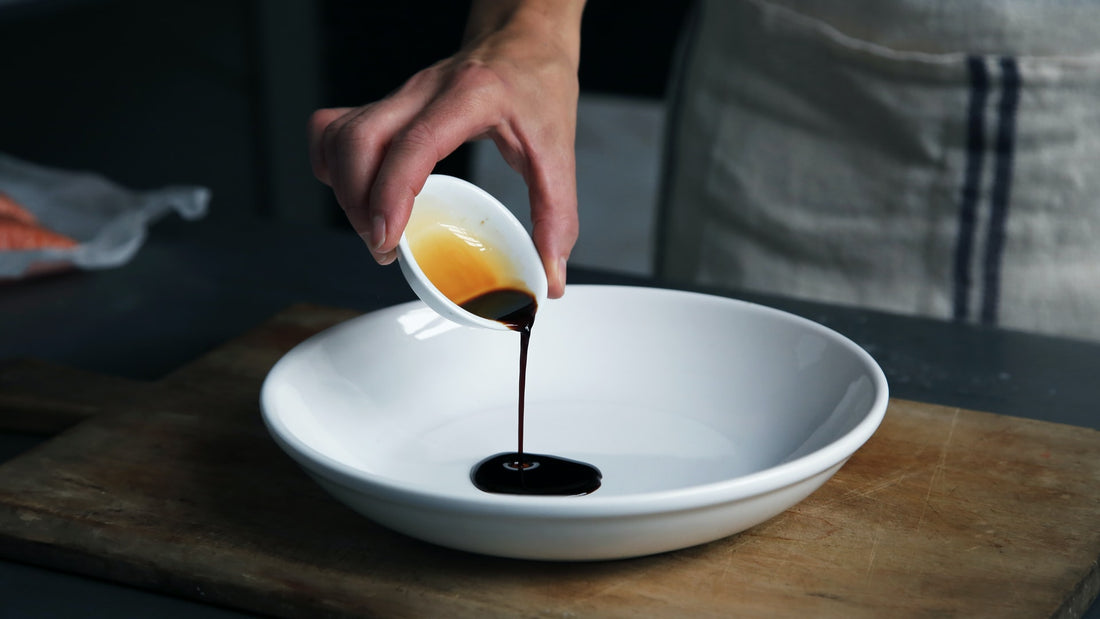
Tangy and flavour-enhancing, vinegar can bring a new dynamic to a range of dishes. Both as an ingredient within a recipe and as a condiment added at the end. Whether you serve it at the table in a stylish pourer or add a splash during the cooking process, there are lots of vinegars with different flavour profiles.
If you’re ready to take your culinary skills to the next level, read on to learn how to use vinegar in cooking and become a flavour pro!
Basics to know about vinegar
Chances are, we all have a bottle of vinegar in the cupboard somewhere, whether it’s an everyday cooking essential or something we occasionally drizzle over chips. But have you ever wondered what vinegar is made from?
Well, at its most basic, vinegar is an acidic liquid produced through the fermentation of other ingredients. There are many types of vinegar, all coming from different ingredient origins. Each can bring a different flavour profile and unique properties to your cooking.
As well as adding flavour, vinegar can preserve food, improve the appearance of a dish, and even fill in for missing ingredients. For example, if you’ve run out of fresh lemon or lime, you can always use ½ teaspoon of vinegar in place of a teaspoon of citrus juice for that flavoursome tang!
Let’s look at some of the most popular types of vinegar...
Vinegar varieties
White vinegar - this kind of vinegar comes from grain-based ethanol or acetic acid, which is diluted with water. It has a strong flavour and is a popular part of Indian cuisine. White vinegar also makes a great all-purpose cleaner!
Rice vinegar - made from rice wine, this liquid has a pale yellow colour and a sweeter taste than other vinegar types. You can use rice vinegar to make dips and dressings and marinate meat.
Apple cider vinegar - because it comes from apple cider, this vinegar has a distinctly fruity flavour. As well as adding a mild sour tang to dishes, apple cider vinegar is thought to have some great health benefits. Many people believe it can promote healthy skin and hair.
Balsamic vinegar - although it comes from fermented grape must, balsamic vinegar contains no alcohol. Dark and highly concentrated, it has a sweet flavour and makes a beautiful accompaniment to salads and cheeses. Mix with a high-quality oil for a delicious dip or serve in an elegant ceramic pourer so guests can add their own.
Of course, this is just a handful of the vinegar types available! If you fancy getting creative in the kitchen, why not explore coconut vinegar, sherry vinegar or even champagne vinegar?
How you should cook with vinegar
Perhaps you’re used to drizzling a bit of vinegar over your meal after serving, but do you often use it within dishes? Here are our tips on how to use vinegar in your cooking and some uses you may not have considered.
Match the vinegar to your dish
As you can see, because vinegar can be made from so many different ingredients, there can be a lot of variation in the flavours, acidity levels, and pungency. Though you can substitute vinegar to a certain degree, having an awareness of the different flavour profiles can help you find the perfect one to complement your recipe.
Use it sparingly
Whichever vinegar you go for, it will probably pack in a lot of flavour! Start with a small amount and add more if you need it — you can always add more, but you can’t take it out again. It’s also a good idea to taste as you go.
Add flavour without salt
Are you trying to reduce your salt intake? A sprinkle of salt certainly enhances a recipe’s flavours. However, for those trying to eat less sodium, vinegar can make a great alternative. A dash of vinegar can help brighten a dish’s flavour profile and can intensify your perception of saltiness.
Why not check out our other ideas on how to add flavour without salt?
Prevent your pasta from sticking
Adding a tablespoon of vinegar to your boiling water is a great way to stop pieces of pasta from sticking together. Alkaline tap water can cause the pasta to release more starch and become sticky. Vinegar acidifies the water to prevent this.
Add vinegar to soups and stews
Vinegar can add depth of flavour to soups, sauces, and stews. Especially great for tomato-based recipes, you can add a couple of tablespoons of vinegar towards the end of the cooking process to amplify the flavours of your other ingredients.
Bake fluffier cakes
Did you know that a bit of vinegar can help you bake lighter cakes? A ¼ teaspoon of vinegar per egg white can give cakes an airier crumb and make for super-fluffy meringues. You can also use apple cider vinegar and baking soda in place of eggs for vegan cakes.
Vinegar: a versatile condiment
A generous dash of salt and vinegar is a classic British recipe-topper. But vinegar has a multitude of uses that go far beyond dressing up your fish and chips. From enhancing the flavours of other ingredients to improving the rise of your cupcakes, there are many ways you can incorporate vinegar into your everyday cooking practice.
Having said that, whether you choose glossy balsamic or fruity apple cider vinegar, the tart condiment can make a great table addition. Why not make a statement and serve your favourite type of vinegar at the table in an attractive classic pourer?

